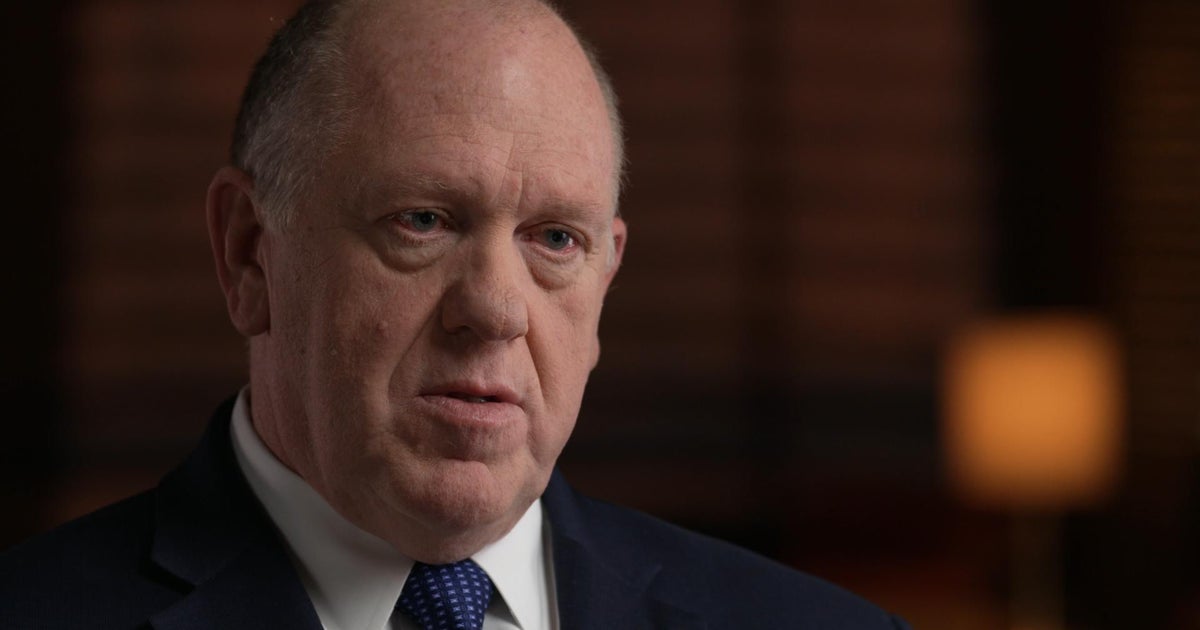CBS News
Trump’s mass deportation plan for undocumented immigrants could cost billions a year

With nine days until Election Day, former President Trump has stepped up his attacks on the Biden-Harris administration’s record on illegal immigration and pledged that, if elected, he’ll conduct the largest deportation in American history.
There are more than 11 million undocumented immigrants living in the United States.…about 3% of the population. Nearly 80% of them have lived in the country for a decade or more.
How realistic is this mass deportation campaign promise? What would be the human and financial cost?
We took these questions to one of the people Donald Trump has said would join him if he wins a second term – Tom Homan… who led immigration enforcement during the first Trump administration when thousands of migrant children were separated from their parents at the border.
Tom Homan: I hear a lot of people say, you know, the talk of a mass deportation is racist. It’s– it’s– it’s threatening to immigrant community. It’s not threatening to the immigrant community. It should be threatening to the illegal immigrant community. But on the heels of [a] historic illegal immigration crisis. That has to be done.
At the Republican National Convention this summer… Tom Homan was the proud pitchman of mass deportation…
Tom Homan speaking at the RNC: I got a message to the millions of illegal aliens that Joe Biden’s released in our country. You better start packing now.
Over three decades, he worked his way up from border patrolman to acting director of Immigration and Customs Enforcement – the agency known as “ICE” — during the first year and a half of the Trump administration.
60 Minutes
This election cycle, former President Trump has mentioned mass deportation at nearly every rally…
Donald Trump: We will begin the largest deportation operation in the history of our country because we have no choice
Cecilia Vega: What would the largest deportation in American history look like to you?
Tom Homan: Well, lemme tell you what it’s not going to be first. It’s not gonna be– a mass sweep of neighborhoods. It’s not gonna be building concentration camps. I’ve read it all. It’s ridiculous.
Cecilia Vega: But if mass deportation is not going to be, as you said, massive sweeps and concentration camps
Tom Homan: It’ll be concentrated
Cecilia Vega: What is it?
Tom Homan: They’ll be targeted arrests. We’ll know who we’re going to arrest, where we’re most likely to find ’em based on numerous inve– you know, investigative processes.
Former President Trump’s running mate JD Vance said it would be reasonable to deport a million people a year…
Trump’s top immigration advisor Stephen Miller told a conservative audience that deportees would be removed from the country in a massive military air operation…
Stephen Miller : So you grab illegal immigrants and then you move them to the staging ground and that’s where the planes are waiting for federal law enforcement to then move those illegals home. You deputize the National Guard to carry out immigration enforcement
Cecilia Vega: Stephen Miller said that this will involve large-scale raids.
Tom Homan: He– I– I don’t use the term “raids,” but you’re probably talking about work-site enforcement operations– which this administration pretty much stopped
Cecilia Vega: Workplace enforcement, that’s a roundup.
Tom Homan: And that’s gonna be necessary. Work-site enforcement operations just not about people who’s working illegally in the country and companies that hire ’em that’s gonna undercut their competition that has U.S. citizen employees. It’s where we find a lot of trafficking cases you know, women and children who are forced into forced labor to pay off their smuggling fees.
A study by the American Immigration Council found that mass deportation could result in the removal of millions of construction, hospitality and agriculture workers– reducing the GDP by $1.7 trillion.
Cecilia Vega: Can you just limit it to criminals and national security threat though?
Tom Homan: If I’m in charge of this, my priorities are public safety threats and national security threats first.
Cecilia Vega: First implies others follow, though, right?
Tom Homan: Absolutely.
Cecilia Vega: So game that out for me. What’s the scenario
Tom Homan: It’s not OK to enter a country illegally, which is a crime. That’s what drives illegal immigration, when there’s no consequences. The Biden-Harris administration has proven this, You can get to the border, turn yourselves in, get released within 24 hours
Cecilia Vega: So you are carrying out a targeted enforcement operation. Grandma’s in the house. She’s undocumented. Does she get arrested too?
Tom Homan: It depends
Cecilia Vega: Which
Tom Homan: Let– let the judge decide. We’re gonna remove people that– a judge’s order deported.
Homan’s suggestion that grandma might face arrest would mark a major shift in policy. Under President Biden, ICE is mostly targeting those deemed national security or public safety threats — and people who just crossed the border illegally.
The majority of the 4 million deportations carried out by the Biden administration have occurred at the southern border, where an unprecedented influx of migrants created scenes of chaos, a humanitarian crisis and one of Vice President Harris’ biggest political vulnerabilities.
Homan says mass deportation is the solution.
Cecilia Vega: How many people would be deported?
Tom Homan: That’s– that’s– you can’t answer that question.
Cecilia Vega: Why not?
Tom Homan: How many officers do I have?
Cecilia Vega: Is there a written plan on this?
Tom Homan: Not that I know of.
Cecilia Vega: If there’s no memo, if there’s no plan, is this fully baked?
Tom Homan: We’ve done it before.
Cecilia Vega: But not– a deportation of this scale.
Tom Homan: ICE is very good at these operations. This is what they do
To see what they do, we went to Silver Spring, Maryland, a suburb of Washington, DC … where earlier this month, ICE agents gathered in a parking lot before dawn …
60 Minutes
It’s what ICE does every day… and has been doing for many years.
Their task this morning– locate and arrest undocumented immigrants with criminal histories including assault, robbery, drug and gun convictions…
… identified by ICE as a threat to public safety
Matt Elliston, director of ICE’s Baltimore field office, told us the goal was to catch the first target by surprise..
Cecilia Vega: You’ve been f– watchin’ him? He– you know– you know his routine?
Matt Elliston: Yeah, we know his routine. We’ve been watchin’ him for a couple days.
Sure enough, a white van soon appeared to pick him up. But they didn’t get very far…
The man they arrested was a 24-year-old Guatemalan with an assault conviction, who had been ordered deported by a judge five years ago.
The ICE agents discovered that the driver of the van was also in the country illegally. They told us he’d been deported once before.
Matt Elliston: He has no criminal record. He was picking up his employee to go to work. It doesn’t make sense to waste a detention bed on someone like that when we have other felons to go out and get today.
Cecilia Vega: A lotta folks might hear you and say like, “Hold on, you’ve got an undocumented immigrant who comes face-to-face with ICE, who’s responsible for deporting folks from this country, and you let him go?”
Matt Elliston: We utilize immigration law to enhance public safety. It’s not to just aimlessly arrest anyone we come across, right? We do targeted enforcement at ICE.
It took a team of more than a dozen officers 7 hours to arrest six people …. and that doesn’t include the many hours spent searching for them.
Cecilia Vega: So how would it even be possible then for ICE to arrest a million people in this country if that mass deportation plan were to take effect?
Matt Elliston: I could say here in Maryland, we would never be able to resource or find th– find that amount of detention, which would be our biggest challenge. Right? And just the amount of money that that would cost in order to detain everybody– you know, it be, you know, at– at the Department of Defense level of financing.
Jason Houser: It’s insane to think about it at this sort of scale.:
Jason Houser, ICE chief of staff during the first two years of the Biden administration, says it costs $150 a night to detain people like those we saw arrested. The average stay as they await deportation is 46 days. One deportation flight can cost a quarter of a million dollars. And that assumes the home country will accept them…. Many like Cuba and Venezuela rarely do.
Cecilia Vega: ICE currently has some 6,000 law enforcement agents. How much manpower would it take to arrest and deport a million people?
Jason Houser: You’re talking, 100,000 official officers, police officers, detention officers, support staff, management staff
Trump adviser Stephen Miller has said staff could come from other government agencies like the DEA.
Jason Houser: The idea that you’re gonna take the FBI, or the Marshal Service, or the Bureau of Prisons, or the Security Service, or FEMA off of their mission sets that protect– and protect our communities will not make us safer.
Immigration enforcement requires specialized training and language skills that most military and law enforcement officers don’t have.
Cecilia Vega: There’s this discussion out there that makes it sound like it’s just an easy swap.
Matt Elliston: It is not an easy swap. So– what I can tell you in, from the Immigration and Nationality Act, immigration law is second to the U.S. tax code in complexity
60 Minutes
Cecilia Vega: We have seen one estimate that says it would cost $88 billion to deport a million people a year.
Tom Homan: I don’t know if that’s accurate or not.
Cecilia Vega: Is that what American taxpayers should expect?
Tom Homan: What price do you put on national security? Is it worth it?
Cecilia Vega: Is there a way to carry out mass deportation without separating families?
Tom Homan: Of course there is. Families can be deported together.
Monica Camacho Perez and her family worry about that. They have lived and worked in the country since coming illegally from Mexico more than 20 years ago.
Cecilia Vega: What scares you the most?
Monica Camacho: I think of– of my nieces and my nephews that they’re gonna get separated from their parents.
They made a life in Baltimore where Monica, who’s 30, teaches English as a second language.
Monica Camacho Perez: We are a normal family, like anybody else, right? We go to church. We work, every day. We pay taxes
She’s among the more than 500,000 undocumented immigrants brought to the country as children who are protected from deportation under the Deferred Action for Childhood Arrivals program- known as DACA.
60 Minutes
Monica Camacho Perez: I’m the only one right now that’s, like, protected, while my parents are not, my brothers are not. My brothers have– children that are born here. So if they were to get deported, what will happen to their kids. Although I have my life here, I think that I would take the decision to go back with my parents, to take care of them.
Cecilia Vega: You would?
Monica Camacho Perez: Yes.
Cecilia Vega: You own a home here. This is the city you grew up in.
Monica Camacho Perez: But…They’re also part of my American dream. And I can’t imagine living here without them.
Like Monica’s nieces and nephews…more than 4 million U.S.-born children live with an undocumented parent.
Cecilia Vega: Why should a child who is an American citizen have to pack up and move to a country that they don’t know?
Tom Homan: ‘Cause their parent absolutely entered the country illegally, had a child knowing he was in the country illegally. So he created that crisis
While Homan ran ICE — in what became one of the most controversial policies of the Trump administration– at least 5,000 migrant children were forcibly separated from their parents, who were prosecuted for crossing the border illegally.
Cecilia Vega: You’ve been called the “father of Trump’s family separation policy.” How does that sit with you?
Tom Homan: Not true. I didn’t write the memorandum to separate families. I signed the memo. Why’d I sign the memo? I was hopin’ to save lives. While you and I are talkin’ right now, a child’s gonna die in the border. So we thought, maybe if we prosecute people, they’ll stop comin’.
And if Trump wins a second term?
Tom Homan: I don’t know of any formal policy where they’re talkin’ about family separations.
Cecilia Vega: Should it be on the table?
Tom Homan: It needs to be considered, absolutely.
Cecilia Vega: Do you think a mass deportation plan would deter other people from coming to this country illegally?
Monica Camacho Perez: No, I don’t think so. Regardless, people are still going to try to come for a better life.
Produced by Andy Court, Annabelle Hanflig, Camilo Montoya-Galvez. Broadcast associate, Katie Jahns. Edited by Craig Crawford.
CBS News
A new generation of shopping cart, with GPS and AI

Watch CBS News
Be the first to know
Get browser notifications for breaking news, live events, and exclusive reporting.
CBS News
“All hands on deck” for Idaho’s annual potato harvest

Watch CBS News
Be the first to know
Get browser notifications for breaking news, live events, and exclusive reporting.
CBS News
Taste-testing “Sandwiches of History” – CBS News

Watch CBS News
Be the first to know
Get browser notifications for breaking news, live events, and exclusive reporting.












